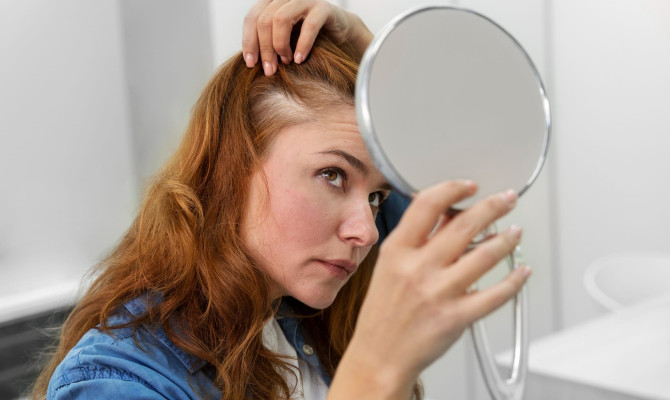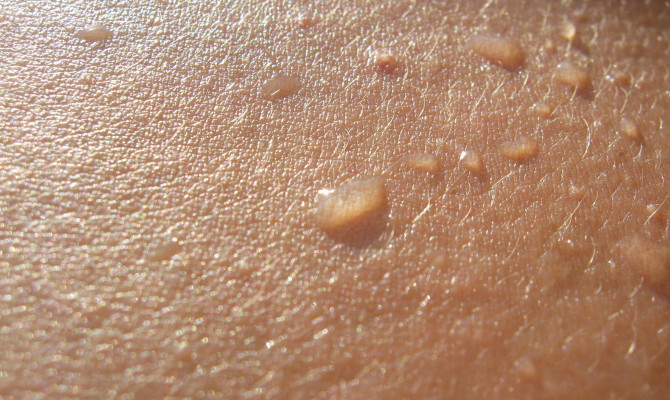Understanding Hirsutism in Women: Causes, Symptoms, and Treatment

- Hirsutism
- 22 Aug 2023
Overview
What is Hirsutism?
Hirsutism in women refers to the presence of a huge amount of coarse and heavy hair in areas where women typically have less hair, such as the face, belly, and other body parts. It is one of the most common hormonal disorders. It affects approximately 10% of females. Hirsutism is typically a manifestation of an underlying issue rather than a standalone medical condition. The acceptance of body hair varies based on cultural norms. If a woman has more body hair than she desires, she should not immediately assume it is hirsutism1Overview| Researched based study from Betterhealth.vic.gov.au
Prevalence
Prevalence
- Hirsutism seems to be more prevalent in people with darker skin tones.
- It can also happen in men, but it may be challenging to identify.
- In youngsters, excessive hair growth indicates early biological changes that generally happen in adolescents as they progress into adulthood.
- The precise occurrence rate could be as low as 10% or possibly higher, even exceeding 50%.
- The psychological impact of this condition varies depending on cultural and societal influences.
- In certain societies where hairlessness is considered a significant aspect of female beauty, even mild hirsutism might be seen as a severe issue. On the other hand, more noticeable hirsutism might be accepted without much concern in different cultural settings.
- Hirsutism is observed in women who stop taking the birth control pill and gain weight2Prevalence| Researched based study from Nlm.nih.gov
Types
Types of Hirsutism
There are two types:
- Hyperandrogenic hirsutism
- Non-hyperandrogenic hirsutism
Hyperandrogenic hirsutism
- A type of hirsutism where women experience excessive hair growth on their body due to higher-than-normal levels of male hormones called androgens.
Non-hyperandrogenic hirsutism
- A type of hirsutism where excessive hair growth on the body is not caused by higher-than-normal levels of androgens. Instead, the excess hair growth may be due to other factors, such as genetics, family history, or certain medications2Types| Researched based study from Nlm.nih.gov
Symptoms
Symptoms of Hirsutism
- Dense and deep-colored hair, as opposed to thin and light-toned.
- Hairs develop in the cheeks and chin, belly, collar area, lower spine area, upper legs, etc.
- Excessive insulin production
- Skipped menstrual cycles
- Periods that come and go unexpectedly
- Inability to conceive
- Masculine voice tone
- Acne & Pimples
- Sudden surge in sexual desire
- Greasy skin3Symptoms| Researched based study from Nidirect.gov.uk
Causes
Main causes of Hirsutism
Polycystic ovary syndrome (PCOS)
- A condition of women’s reproductive system in which they may have small cysts on their ovaries.
Androgen-secreting tumor
- A type of abnormal growth in the body that produces excessive androgens.
Cushing’s syndrome
- An occurrence that arises when the body experiences extended periods of exposure to increased levels of a chemical substance (also called hormones) named cortisol.
Adrenal hyperplasia
- A hereditary disorder that impacts the adrenal glands.
- These glands have a vital function in generating hormones that control different body processes, such as chemical processes that occur within a living organism and how the body reacts to stress.
- In this condition, these particular glands can produce excessive or insufficient amounts of specific hormones.
Hyperinsulinemia
- This refers to having high levels of insulin, a hormone that helps control blood sugar levels, in the blood.
Hyperprolactinemia
- This means having high levels of a hormone called prolactin, which is responsible for milk production in breastfeeding women.
Steroids
- Steroid drugs prescribed to address different diseases, such as allergies.
Acromegaly
- An uncommon disorder that occurs when the body produces too much growth hormone, typically as a result of a non-cancerous tumor in the pituitary gland.
Hypothyroidism
- A medical condition distinguished by a hypoactive thyroid gland, resulting in inadequate synthesis of thyroid hormones.
Anorexia nervosa
- A mental health condition in which individuals have an extreme fear of gaining weight and often drastically limit their food intake1Causes| Researched based study from Betterhealth.vic.gov.au
Diagnosis
Diagnosis of Hirsutism
Physical assessment & family history
- A thorough medical background is collected, and an all-encompassing physical assessment is conducted.
- Around half of the women with hirsutism report a family history of the condition, hence taking family history is significant.
Blood tests
- Blood tests are done to check the level of androgen, the hormone that causes facial hair growth in females.
Ultrasonography
- Pelvic ultrasonography is a type of imaging test that can be performed to check for any abnormal growth or cysts in the ovaries.
- It helps detect conditions like ovarian tumors or polycystic ovaries4Diagnosis| Researched based study from Nlm.nih.gov
Treatment
Treatment of Hirsutism
Medicines
- Anti-androgens – Substances that hinder the natural production of male hormones in the body, which, in turn, can reduce the rate of new hair growth.
- Birth control pills – These are effective in reducing the levels of androgens in the body, making them a suitable choice for women who want to avoid pregnancy in the near term.
- GnRH agonists – A type of treatment used for severe hirsutism in women who do not respond well to birth control pills and anti-androgens. These drugs are given through injections and work by reducing the production of hormones, which helps in reducing excessive hair growth.
- Eflornithine – The most prevalent prescribed cream is eflornithine, which is designed to slow down the growth of facial hair.
Procedures
- Electrolysis – A procedure where thin needles are inserted into the hair follicles, and they release electrical charges to destroy the unwanted hair follicles.
- Laser therapy – This uses focused lasers to damage hair follicles, causing unwanted hair to fall out.
Remedy
- Shaving- This is the most secure and straightforward method to eliminate undesired hair. It is also cost-effective, but the downside is that you may need to shave daily to maintain smooth skin.
- Plucking- Plucking is beneficial for getting rid of a couple of random hairs.
- Waxing: This method is more efficient for eliminating extensive areas of hair.
- Bleaching: This procedure bleaches the shade of undesirable hair, rendering it less conspicuous.
- If you are overweight, consider focusing on losing the mass of the body and sustaining a nutritious diet. Some women have found that doing so can help balance their hormones.
- Women experiencing hirsutism may struggle with self-esteem issues due to the emotional difficulty of dealing with excessive hair growth. Obtaining therapy or participating in a support network can be advantageous in dealing with these difficulties5Treatment| Researched based study from Familydoctor.org
Diet
- Steer clear of processed foods, particularly sugary items.
- Incorporate fruits and vegetables into your diet, like blueberries, tomatoes, etc.
- Avoid alcohol and tobacco
- Reduce the intake of red meats and opt for meats that have a lower fat content more often.
- Ensure you daily drink enough water.
- Incorporate nutritious oils into your diet, such as olive oil6Treatment| Researched based study from Mountsinai.org
Prevention
Can Hirsutism be prevented?
- Preventing hirsutism depends on identifying and addressing the underlying cause.
- For women with PCOS, weight management through a well-rounded diet and consistent physical activity can be advantageous.
- Research indicates that obese women with PCOS may have a lower risk of developing hirsutism if they follow a low-calorie diet.
- For some individuals, genetic factors can contribute to hirsutism and it may not be entirely preventable in such cases6Prevention| Researched based study from Mountsinai.org
Complications
What are the complications?
- Hirsutism typically does not pose major health risks, but it can cause emotional and psychological challenges for many women due to its troublesome and embarrassing nature.
- While hirsutism may not be a severe medical issue, the emotional toll it exacts on those affected can be substantial.
- Seeking appropriate support and treatment options is crucial to tackling both the bodily facets and psychological dimensions of the condition7Complications| Researched based study from Medlineplus.gov
Prognosis
Prognosis
- The outlook for hair growth improvement is generally positive but may require patience.
- Hair follicles have a growth cycle of about 6 months, so it takes several months of consistent medication use before a noticeable reduction in hair growth occurs.
- Many women find success with temporary hair removal methods or hair-lightening treatments to manage the condition effectively7Prognosis| Researched based study from Medlineplus.gov
Takeaway
Takeaway tips
- If you notice excessive hair growth, consult a healthcare professional for proper evaluation and diagnosis to identify the underlying cause of hirsutism.
- For those experiencing polycystic ovary syndrome-linked hirsutism, adopting a well-balanced diet and engaging in consistent physical activity might aid in alleviating symptoms.
- Hirsutism cannot be cured permanently. However, depending on the cause of hirsutism, your doctor may prescribe medications or hormone therapy to regulate hormone levels and control hair growth.
- For those seeking more permanent results to get rid of hirsutism, consider treatments like laser hair removal or electrolysis, but consult a healthcare professional before proceeding.
- Stay on top of regular health check-ups and follow-up appointments with your healthcare provider to monitor progress and adjust treatment plans if necessary.
- Addressing hirsutism may take time, so be patient and persistent with your chosen treatment methods.
Any feedback on this article?
 This Articles content was accurate
This Articles content was accurate Very Informative Article
Very Informative Article I have a question or a comment
I have a question or a comment
 This article contains inaccurate content
This article contains inaccurate content This article was not helpful
This article was not helpful I have a question or a comment
I have a question or a comment
We appreciate your helpful feedback!
Checkout our social pages
References
-
Better Health Channel
Hirsutism | Overview | Causes
-
National Library of Medicine
Hirsutism | Types | Prevalence
-
Nidirect
Hirsutism | Symptoms
-
National Library of Medicine
HIRSUTISM: EVALUATION AND TREATMENT | Diagnosis
-
American Academy of Family Physicians
What is hirsutism? | Treatment
-
Mount Sinai
Hirsutism | Treatment | Prevention
-
Medline Plus
Excessive or unwanted hair in women | Complications | Prognosis
















